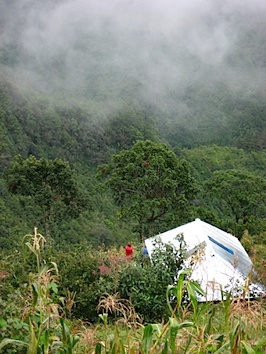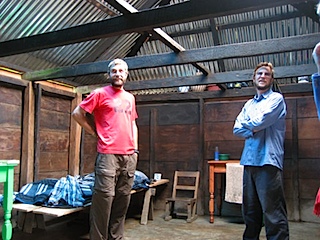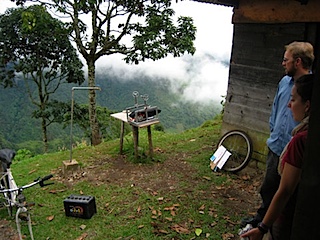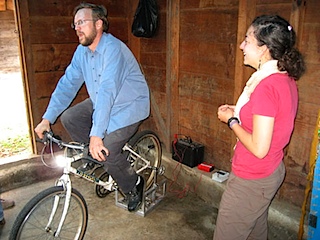 We finally got to visit the site of our buddies Niko and Katal. They are the new volunteers that started in August… you know, the ones we were originally going to send to Quixabaj until that deal fell through. Well, I am pleased to announce that they are getting along great in their new home. I can’t tell you what the name of the NEW village is, because the Peace Corps sees that as a potential security issue. But I will tell you that it’s beautiful: much like ours, but more so. We’re remote, but they have half an hour more of travel than us. We live on a mountainside, but theirs is even steeper. Our village is tiny, but theirs is just a few houses clumped together. We don’t have a toilet, or running water, or solid walls on our house… but they don’t even have electricity. It’s Peace Corps as it was meant to be.
We finally got to visit the site of our buddies Niko and Katal. They are the new volunteers that started in August… you know, the ones we were originally going to send to Quixabaj until that deal fell through. Well, I am pleased to announce that they are getting along great in their new home. I can’t tell you what the name of the NEW village is, because the Peace Corps sees that as a potential security issue. But I will tell you that it’s beautiful: much like ours, but more so. We’re remote, but they have half an hour more of travel than us. We live on a mountainside, but theirs is even steeper. Our village is tiny, but theirs is just a few houses clumped together. We don’t have a toilet, or running water, or solid walls on our house… but they don’t even have electricity. It’s Peace Corps as it was meant to be.
Niko and Katal are NOT a couple, which confuses the heck out of the locals. They are just two volunteers of opposite sex that happen to be assigned to the same site. The Peace Corps normally doesn’t do that, but their village is so remote and there are so many work possibilities that everyone thought it would be a worthwhile experiment.
Therefore, they have two separate houses. By separate, I mean there is about 3 feet between them. That’s funny, since the other houses in the valley are so far apart you can’t even see them. But their houses are quaint, cute, and (as of last week) have water-tight roofs. They are made of wood planks, like ours, and they took out the ceilings to open the places up (Niko’s house had a ceiling so low that he had to stoop to move around).
They also have a pretty dramatic front yard with views into the valley a thousand feet below. Notice the water tap in the second picture; yes, they have running water, unlike us. I think if I had to pick between electricity and running water, I’d rather have electricity, thank you. Though, a lack of electricity is easier to fix.
Here we have Makali, our safety and security guy (and all around cool dude), demonstrating how to use the new bicycle generator that he brought for them. Peace Corps Guatemala is testing the technology, to possibly use for future volunteers in remote locations. It is manufactured by a small business near Antigua called Maya Pedal. It’s pretty simple- a welded frame to hold the back of the bike off the ground, with an adjustable armature to touch the wheel to the driveshaft of an alternator. Wires from the alternator go to a lead-acid car battery, and charge is monitored by a battery meter attached with alligator clips. Pedal, and it charges. To get power out, you clip on the wires from a small power inverter, the kind you plug into the cigarette lighter in your car, and then you can do things like run your laptop or charge your cell phone.
Niko and Katal are excited about their new power, but are also a little worried. Since they arrived in their site, the villagers have been coming by asking to charge their cellphones. I have a suspicion that the villagers think electricity grows on gringoes, just like American kids think money grows on trees. Until now, Nico and Katal couldn’t help; but now they have a bike generator. They will have to be careful, or they will get visitors at all hours requesting a quick charge, just like we get people wanting photographs taken. Asi es, as they say. That’s how it is.


